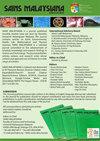Physical Properties of Tapioca Starch-based Film Indicators with Anthocyanin Extract from Purple Sweet Potato (Ipomea batatas L.) and Response to pH Changes
IF 0.7
4区 综合性期刊
Q3 MULTIDISCIPLINARY SCIENCES
引用次数: 2
Abstract
Intelligent packaging comes in the form of interactive film indicator using a natural pigment compound sensitive to pH changes. The development of intelligent packaging as an indicator film by utilizing natural pigment compounds that are related to pH change and food safety is motivated by increased consumer awareness of food safety. Purple sweet potato (Ipomoea batatas L.) is the source of anthocyanin flavonoid compounds sensitive to pH changes, demonstrated by color changes in film indicators. This research aims to determine physical properties and the pH response of tapioca starch-based film indicators with anthocyanin extract variation from purple sweet potato. Purple sweet potato anthocyanin (PSPA) indicator film was made using tapioca starch as biopolymer by casting method with the addition of anthocyanin extract at concentrations of 0, 5, 10, and 15 g. Furthermore, this research is conducted to analyze the physical properties of the film, and response to pH changes of fresh cow milk, Gindara fish fillet and chicken sausage stored at 7 °C and 25 °C under 48-hour observation. The results showed that the film indicator thickness was 0.72-0.74 mm, tensile strength was 1.23-9.86 MPa, elongation was 14.83-55.74%, and water vapor permeability (WVP) was 1.32-1.78 × 10-14 kg.m/m2.s.Pa. The results of this study indicated that the PSPA indicator films have the potential to be used as smart packaging to monitor food freshness and quality for safe consumption. That was supported by the good physical properties of PSPA indicator films.紫薯花青素提取物对木薯淀粉基薄膜指示剂的物理性质及对pH变化的响应
智能包装以互动薄膜指示剂的形式出现,使用对pH值变化敏感的天然色素化合物。利用与pH值变化和食品安全相关的天然色素化合物开发作为指示膜的智能包装,是受到消费者食品安全意识提高的推动。紫甘薯(Ipomoea batatas L.)是花青素类黄酮化合物的来源,对pH值变化敏感,这可以通过薄膜指标的颜色变化来证明。本研究旨在通过紫甘薯花青素提取物的变化来测定木薯淀粉基薄膜指标的物理性质和pH响应。以木薯淀粉为生物聚合物,加入浓度分别为0、5、10、15 g的花青素提取物,采用浇铸法制备紫薯花青素指示膜。此外,本研究还分析了膜的物理性质,以及在7℃和25℃条件下保鲜48小时对鲜牛奶、金达鱼片和鸡肉香肠pH变化的响应。结果表明:薄膜指示厚度为0.72 ~ 0.74 mm,抗拉强度为1.23 ~ 9.86 MPa,伸长率为14.83 ~ 55.74%,水蒸气透气性(WVP)为1.32 ~ 1.78 × 10-14 kg.m/m2.s.Pa。本研究结果表明,PSPA指示膜具有作为智能包装监测食品新鲜度和质量安全消费的潜力。这得益于PSPA指示膜良好的物理性能。
本文章由计算机程序翻译,如有差异,请以英文原文为准。
求助全文
约1分钟内获得全文
求助全文
来源期刊

Sains Malaysiana
MULTIDISCIPLINARY SCIENCES-
CiteScore
1.60
自引率
12.50%
发文量
196
审稿时长
3-6 weeks
期刊介绍:
Sains Malaysiana is a refereed journal committed to the advancement of scholarly knowledge and research findings of the several branches of science and technology. It contains articles on Earth Sciences, Health Sciences, Life Sciences, Mathematical Sciences and Physical Sciences. The journal publishes articles, reviews, and research notes whose content and approach are of interest to a wide range of scholars. Sains Malaysiana is published by the UKM Press an its autonomous Editorial Board are drawn from the Faculty of Science and Technology, Universiti Kebangsaan Malaysia. In addition, distinguished scholars from local and foreign universities are appointed to serve as advisory board members and referees.
 求助内容:
求助内容: 应助结果提醒方式:
应助结果提醒方式:


